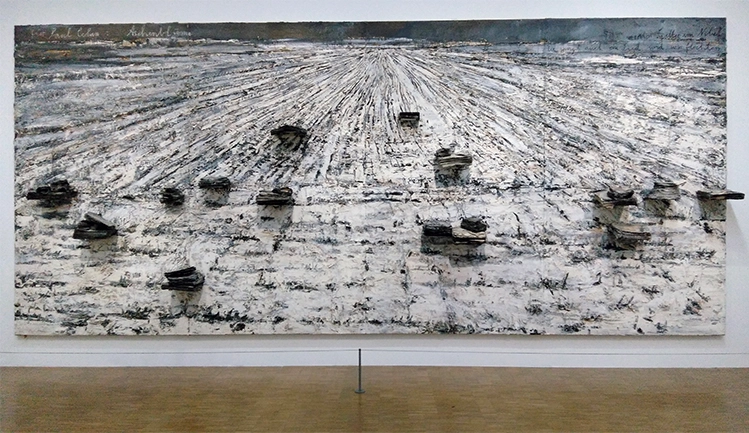
Vue d’installation, Croissy, 2015© Anselm Kiefer Photo © Anselm Kiefer
There are artists that you love, artists that you like (or dislike), and artists who alter the way you think of the world and reflect on your own art practice. For me, this happened recently while coming face to face with the enormity of the works of Anslem Kiefer. Large in scale, serious in disposition, and unrivaled in their materiality I was absorbed into them. I don’t often have experiences where I am so completely taken by the “realness” of art. But coming away from his work I felt altered in some way. There is a weight to Kiefer’s paintings which transfers into the viewer’s being.


For those of you unfamiliar with Kiefer, he is a German artist born in the Black Forest of Germany at the end of the second world war. Through his work he has explored and ripped open Germany’s past with a fearlessness that brought him into the spotlight at a young age. His work deals with themes of memory, responsibility, renewal and decay. But while the seriousness of his work is evident, there is a beauty which he’s created that underlies even the darkest of his pieces. With a major retrospective having just taken place at the Centre Pompidou and a concurrent solo exhibition at the Bibliothéque National de France, he has been all over Paris in the past months. His work is important, serious, hard to look at, and yet impossible to look away from.
I wanted to share a few things that struck me while viewing the exhibition at the Bibliotheque National de France, and also lessons that I’m taking back into my own work. This exhibit focused on the collection of Kiefer’s art books which he has created as side projects throughout his career. The books are a recurring motif in his paintings, installations and sculptural works alike. And the books in this exhibition, as in all his other work, were big, heavy, textured, and provided small glimpses into his thoughts and inspirations. But it wasn’t the books that grabbed me here. It was one of the paintings which bookended the exhibition.

Anselm Kiefer, “Lichtung” (Clairière), 2015, collection particulière © Anselm Kiefer – photo © Georges Poncet
The painting is named Lichtung, which translated to English means a clearing in the forest. I love it for the way it lives in a gray area—both alluding to something more and just being itself all at the same time.
Looking at Kiefer’s paintings is something of an experience. The painting swallows you in its enormity and engulfs you in its texture. The massive landscapes makes you forget a moment of your current surroundings and pulls you into the realm of suspended disbelief as you are fully emerged in his world. The materiality of the painting beckons for you to touch it, and renders the world tangible and real. The monochromatic color scheme also invites you into a place that is timeless. It is not entirely melancholy although that feeling is there, among the burned books and chaotic paint strokes. But strong feelings of this kind are taken away as your eye flints from glimmer to glimmer of the gold and silver leaf falling onto and through the landscape. They invoke questions and associations of fire, ashes, falling snow, memory, destruction and hope. It tells a story of a time when books were burned, history was in chaos, and times were dark and bleak. But there is redemption in this painting and that is what I find makes it so beautiful. It is a memory, but it is also the present. It is a new beginning built on the remains of a past that is not forgotten but able to be changed in the future. In the darkness there is hope; in the suffering there is beauty.

One of my favorite thing about this painting is the layering of meaning. The books in the center are the most obvious as they jump out at you. They make me think of the historical burning of books, the destruction of culture that can be traced back to many histories and is still prevalent in areas of the world today. But couldn’t they also be a metaphor for how we try to erase hard truths? How we try to cover up and forget past sins…either personally or socially? The books become a reminder to not forget the past, to meditate on hard truths.
There is a use of evergreens in this work…formed in a circle to create a clearing where the pile of ashes find themselves. I see them as a symbol of life…they juxtapose with the fate of the books as an ever living thing, encircling them. It makes me think of the life cycle and the evident renewal. The idea of rebirth, of life and death together, of redemption and forgiveness through fire and adversity. It is layered with meaning and reads like a poem.
From the scale, materials, colors, imagery, and emotional associations that it evokes, the genius of Kiefer shines through at every stage. It is something I could look at for hours and contemplate. The exhibition is now closed, but if you ever have a chance of seeing his work in person, I would suggest going. It’s something that will bring you out of this world for just a moment and allow you to experience a new way of thinking and looking at the world.
My favorite paintings and works of art live in a space of ambiguity and layered meaning. When art makes you ask questions, make connections, and rethink the world around you—then that is a powerful piece; and this was a powerful piece.
*Unfortunately I lost all my photos of the exhibition, so some images were taken from CultureBox.